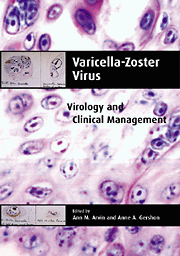Book contents
- Frontmatter
- Contents
- List of contributors
- Preface
- Introduction
- Part I History
- Part II Molecular Biology and Pathogenesis
- 2 Molecular evolution of alphaherpesviruses
- 3 DNA replication
- 4 Viral proteins
- 5 Pathogenesis of primary infection
- 6 Pathogenesis of latency and reactivation
- 7 Host response to primary infection
- 8 Host response during latency and reactivation
- 9 Animal models of infection
- Part III Epidemiology and Clinical Manifestations
- Part IV Laboratory Diagnosis
- Part V Treatment and Prevention
- Index
- Plate section
6 - Pathogenesis of latency and reactivation
from Part II - Molecular Biology and Pathogenesis
Published online by Cambridge University Press: 02 March 2010
- Frontmatter
- Contents
- List of contributors
- Preface
- Introduction
- Part I History
- Part II Molecular Biology and Pathogenesis
- 2 Molecular evolution of alphaherpesviruses
- 3 DNA replication
- 4 Viral proteins
- 5 Pathogenesis of primary infection
- 6 Pathogenesis of latency and reactivation
- 7 Host response to primary infection
- 8 Host response during latency and reactivation
- 9 Animal models of infection
- Part III Epidemiology and Clinical Manifestations
- Part IV Laboratory Diagnosis
- Part V Treatment and Prevention
- Index
- Plate section
Summary
Introduction
Infections with herpesviruses are characterized by intermittent bouts of symptomatic or asymptomatic recrudescence (Straus, 1994; Roizman, 1996). The ability to cycle between productive and latent infection is a hallmark of infections by members of this family of viruses. The alphaherpesviruses, including herpes simplex viruses 1 and 2 (HSV-1; HSV-2) and the varicella-zoster virus (VZV), have evolved genetically defined and effective strategies to infect, persist latently within, and reactivate from neuronal tissues. The aim of this chapter is to summarize the existing body of data regarding VZV latency, how it is established, the specific cell types in which the virus persists, the state of VZV during latency, and factors that might regulate its reactivation.
HSV latency
The mechanism by which HSV-1 and -2 establish and maintain latency is different from that of VZV. The differences are readily evident when considering the clinical patterns of infection with each of these viruses (Meier & Straus, 1992; Straus, 1993). As these differences provide important clues to the individual mechanisms for latency that underlay them, they are worth summarizing here.
HSV reactivates at a surprisingly high frequency. Individuals may experience hundreds of clinically apparent recurrences of genital or labial lesions during their lifetimes (Corey & Spear, 1986; Whitley, 1996). Moreover, numerous episodes arise in which the virus reactivates without causing recognized symptoms. Virus can be recovered from sites of prior infection of individuals lacking such symptoms on 1–3% of days; viral DNA can be detected in swabs of those sites on 5–15% of days using PCR assays (Koelle et al., 1992; Cone et al., 1994; Schacker et al., 1998).
Information
- Type
- Chapter
- Information
- Varicella-Zoster VirusVirology and Clinical Management, pp. 123 - 141Publisher: Cambridge University PressPrint publication year: 2000
Accessibility standard: Unknown
Why this information is here
This section outlines the accessibility features of this content - including support for screen readers, full keyboard navigation and high-contrast display options. This may not be relevant for you.Accessibility Information
- 12
- Cited by
